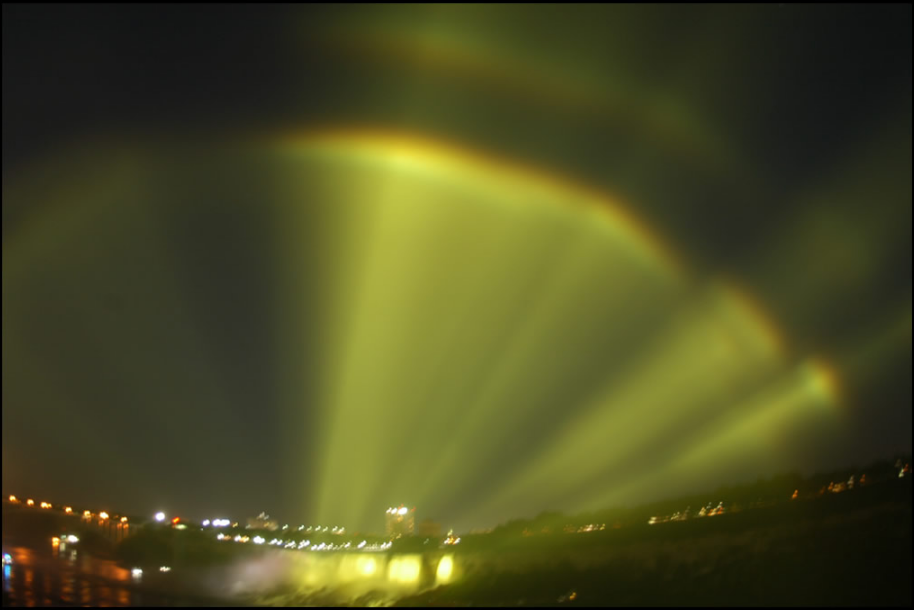Niagara Searchlight Rainbows - OPOD
Niagara Searchlight Rainbows - OPOD
When we think of Niagara Falls, we often picture the majestic cascade of water and the ethereal mist that surrounds it. But did you know that the mist and spray from Niagara Falls also create mesmerizing rainbows? One such phenomenon is known as the Niagara Searchlight Rainbows. In this article, we will delve deeper into this atmospheric optics spectacle and uncover the science behind its unique appearance.
The bows captured by atmospheric optics expert Michael Ellestad are unlike traditional rainbows. Instead of a smooth arc, these bows appear to radiate out from lights near the American Falls and are curiously disjointed. At first glance, it may seem puzzling, but appearances can be deceiving.
The key to understanding the Niagara Searchlight Rainbows lies in the floodlights positioned behind the camera on the Canadian side. These floodlights project light downwards and across the river to illuminate the American Falls. The interaction between the floodlight beams and the mist creates the fragmented bow effect. The rays that converge towards the Falls are known as antisolar rays or, more accurately, 'anti-floodlight' rays.
Each fragment of the bow is created by a separate floodlight beam pointing in a different direction. This is why the bows do not join together smoothly and have different centers. It's a beautiful example of how light interacts with water droplets in the atmosphere to create stunning optical phenomena.
To further illustrate this phenomenon, let's take a look at a photograph by Michiel de Boer. In the image, we can see the banks of floodlights on the Canadian side. The lights in the foreground shine on the Canadian Falls, while those in the background cross the river towards the American Falls, contributing to the creation of the unique bow pictured above.
While the Niagara Searchlight Rainbows are undoubtedly captivating, it's important to note that they are not the only rainbows found at Niagara Falls. Michael Ellestad has also captured the more familiar bows formed by sunlight interacting with the mist from the falls. These rainbows, built of sunshine and Niagara mist, exhibit the classic arched shape that we associate with this natural phenomenon.
In conclusion, the Niagara Searchlight Rainbows are a fascinating example of how light and mist interact to create optical wonders. The disjointed appearance of these bows is a result of separate floodlight beams projecting in different directions. As we marvel at the beauty of Niagara Falls, let us also appreciate the intricate science behind these enchanting rainbows.

Niagara Floodlight Bows
The mist and spray from Niagara falls is famous for creating rainbows. See the bottom of this page for an example.
The bows at left, imaged by atmospheric optics expert Michael Ellestad, are different for they appear to radiate out from lights near the American Falls and are also curiously disjointed.
Appearances deceive. Floodlights behind the camera on the Canadian side are beaming downwards and across the river to light the American Falls. Their light creates the bow fragments and the rays converging to the Falls are in effect antisolar rays or more correctly, 'anti-floodlight' rays.
The bows do not join together smoothly because they are each created by a separate floodlight beam pointing in a different direction. Each fragment therefore has a different centre.
Images ©Michael Ellestad, shown with permission

Proof that separate floodlights create the bows. Here the lights have different colours.

All is revealed
This picture by Michiel de Boer shows the banks of floodlights on the Canadian side. Those in the foreground shine on the Canadian Falls. In the background are the beams crossing the river towards the American falls and creating the bow pictured above.
Below:
Michael Ellestad has pictured the more familiar bows built of sunshine and Niagara mist.

Note: this article has been automatically converted from the old site and may not appear as intended. You can find the original article here.
Reference Atmospheric Optics
If you use any of the definitions, information, or data presented on Atmospheric Optics, please copy the link or reference below to properly credit us as the reference source. Thank you!
-
<a href="https://atoptics.co.uk/blog/niagara-searchlight-rainbows-opod/">Niagara Searchlight Rainbows - OPOD</a>
-
"Niagara Searchlight Rainbows - OPOD". Atmospheric Optics. Accessed on November 25, 2024. https://atoptics.co.uk/blog/niagara-searchlight-rainbows-opod/.
-
"Niagara Searchlight Rainbows - OPOD". Atmospheric Optics, https://atoptics.co.uk/blog/niagara-searchlight-rainbows-opod/. Accessed 25 November, 2024
-
Niagara Searchlight Rainbows - OPOD. Atmospheric Optics. Retrieved from https://atoptics.co.uk/blog/niagara-searchlight-rainbows-opod/.